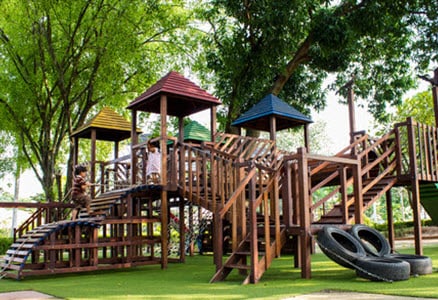
Playgrounds aren’t always fun and games. Every year, emergency room doctors treat about 200,000 children who were injured at playgrounds. Most of these injuries are falls. Serious fall injuries are especially common on older playgrounds which don’t have the proper rubber or other protective surfaces.
A few less common types of playground injuries are strangulations and burns. Hoodie ties sometimes get caught in monkey bars and other kinds of playground equipment. Additionally, the sun superheats slides and other surfaces to incredible temperatures.
These incidents often cause head injuries, broken bones, painful burns, and other serious wounds that cost thousands of dollars to treat. Usually, the playground owner is financially responsible for these and other accident-related damages. More on that below.
Playground owners usually don’t take these cases lying down. Instead, they hire an expensive team of lawyers who work hard to reduce or deny compensation, regardless of the facts in the case. Victims need a determined Columbia child injury attorney to even the odds and obtain the compensation they need and deserve.
Duty of Care
Legally, children at public and private playgrounds are invitees, at least in most cases. Assuming the children follow, or at least mostly follow, any posted playground rules, they have permission to be at the play park. Additionally, their presence benefits the owner. That benefit could be intangible, like the benefit of knowing kids like to play on the playground.
In these cases, property owners have a duty of reasonable care. Warning children and caregivers about a hazard isn’t enough. The owner must do something about that hazard. We mentioned unprotected surfaces above. A duty of reasonable care means an owner has a responsibility to make that surface safer.
Theoretically, a lesser duty of care may apply in some situations, like a child who’s playing at a park after hours. Pragmatically, that’s not the case.
The attractive nuisance rule usually applies to playground injuries. Children play at playgrounds, even if it’s dark or stormy or not otherwise safe. Children also like to play in railroad yards, construction areas, and swimming pools, even though these areas aren’t particularly safe either.
Because kids are kids, South Carolina law protects them with a duty of reasonable care, even if a child victim doesn’t ordinarily qualify for protection under state law.
Knowledge of Hazard
Owners are only responsible for playground injuries if they know, or should know, about the injury-causing hazard.
Direct evidence of actual knowledge is the best evidence in these cases. Claims that are based on the best available evidence usually guarantee maximum compensation. Direct evidence of actual knowledge includes safety survey reports and prior playground injuries at that location.
Circumstantial evidence of constructive knowledge (should have known) is also admissible in these cases.
Think of a banana peel on the floor. If the peel was yellow when the victim slipped and fell, it probably just fell on the floor, so the owner isn’t liable for damages. If the peel was gritty and black, like many people had walked on it, that means it had been on the floor for a good amount of time and the owner should have known about it and should have done something about it.
Compensation in a playground injury case usually includes money for economic losses, such as medical bills, and noneconomic losses, such as pain, suffering, and scarring. A Columbia personal injury attorney may be able to obtain punitive damages as well, in some extreme cases.
Connect With a Detail-Oriented Richland County Lawyer
Injury victims may be entitled to significant compensation. For a free consultation with an experienced personal injury lawyer in Columbia, contact the Marc Brown Law Firm. We do not charge upfront legal fees in these matters.
Source:
nsc.org/community-safety/safety-topics/child-safety/playground-safety